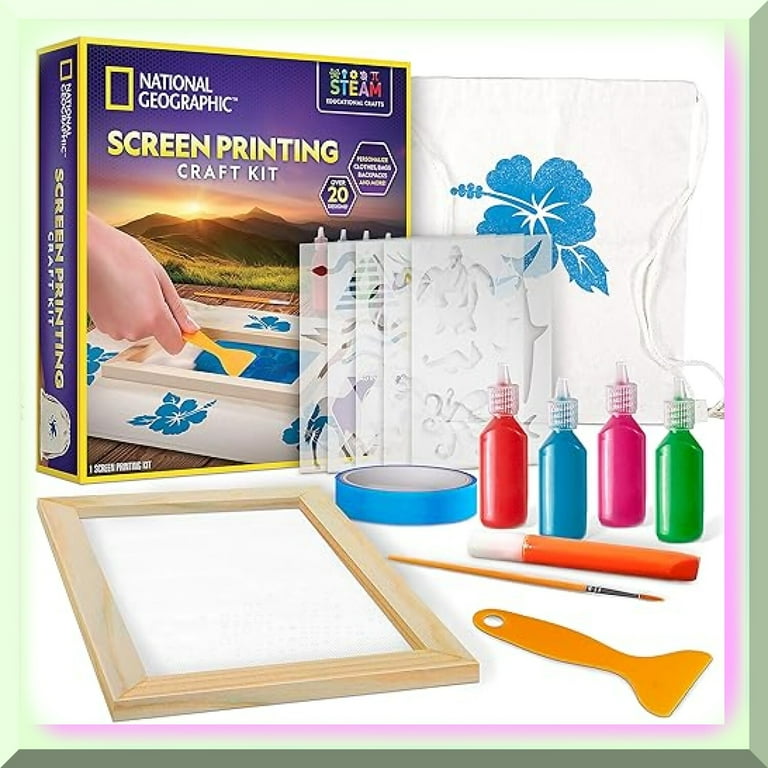Eco-Friendly Custom Screen Printing Options Available
Eco-Friendly Custom Screen Printing Options Available
Blog Article
Understanding Silk Screen Printing: Idea for Creating Stunning Layouts
If you're looking to grasp silk display printing, you'll require more than simply enthusiasm. By the end, you'll be prepared to create spectacular layouts that reflect your special design.
Comprehending the Basics of Silk Screen Printing
Silk display printing, frequently called screen printing, is a versatile technique for moving designs onto different products. You'll locate it's ideal for printing on fabrics, paper, plastic, and much more. The process involves creating a pattern, or display, that allows ink to go through only in details areas, generating lively and tidy designs.
To start, you'll require to prepare your artwork, ensuring it remains in a suitable format. screen printing kit. You'll layer your display with a light-sensitive solution and expose it to light once you've obtained your layout all set. This step creates a stencil of your style on the screen
After washing out the unexposed solution, you're set to publish. Straighten your screen over your material, use ink, and utilize a squeegee to push the ink via the screen. It's everything about method and patience, so do not be reluctant to experiment and fine-tune your method as you go.
Crucial Tools and Products You'll Require
To get begun with silk display printing, you'll require a few basic products like screens, squeegees, and ink. As soon as you fit, you can check out advanced devices that enhances your printing high quality and performance. Let's go over what you'll call for to guarantee your projects achieve success from the beginning.
Basic Silk Display Materials
Beginning on a silk display printing job calls for a few essential tools and products to guarantee your success. You'll require a silk display structure, which holds the mesh that moves your design. A squeegee is important for pushing ink with the screen onto your substratum. Don't neglect the ink itself; select shades that match your design and the material you're publishing on. A light is crucial for exposing your display, together with emulsion to develop your stencil. You'll additionally need a correct work area, ideally one that's free and well-lit from dust. Ultimately, stock up on cleansing materials to preserve your devices and keep your screens in excellent condition. With these basics, you're ready to dive right into your project!
Advanced Printing Equipment
When you're prepared to take your silk display printing to the next level, buying advanced printing devices can make a substantial distinction. A high-grade display printing machine is essential; search for a multi-color press that enables accurate enrollment and quicker production. You'll additionally wish to upgrade to a more efficient direct exposure device to ensure your styles are vivid and sharp.
Think about buying a trusted heat resource, like a conveyor dryer, for even treating of inks. Don't forget specialized inks; water-based and discharge inks give exceptional results on different materials. An excellent collection of squeegees and emulsion scoop coater will certainly simplify your process, providing your designs that specialist side.
Preparing Your Artwork for Printing
Preparing your art work for silk screen printing is essential to achieving lively, professional results. Begin by verifying your layout is in the appropriate style-- vector files like.AI or.EPS work best.
As soon as your file is prepared, create a separate layer for each and every color in your layout. This'll make it less complicated during the printing process. Do not fail to remember to include registration marks to straighten colors appropriately.
Also, consider the mesh matter of your display; finer information might call for a higher mesh matter. Ultimately, save your art work with a resolution of at the very least 300 DPI to assure crisp prints. By adhering to these actions, you'll set yourself up for a successful printing experience and bring your layouts to life beautifully.
The Display Printing Process: Step-by-Step
Since you have actually prepared your artwork, it's time to focus on the screen printing process itself. You'll start by preparing your screen, guaranteeing it's prepared for the ink application. From there, you'll explore numerous printing strategies to attain the very best outcomes for your project.
Preparing Your Screen
Obtaining your screen all set is an essential step in the silk screen printing process. Clean the screen extensively to get rid of any type of dirt, deposit, or oil. Utilize a degreaser and wash it well to assure a smooth surface area for your emulsion. Next off, use a light layer of emulsion evenly throughout the screen utilizing a scoop coater. Make certain to do this in a dimly lit area to stop premature exposure. Allow the solution to completely dry completely prior to revealing it to your design. As soon as dry, position your openness on the screen and make use of a light to expose the layout. After direct exposure, wash out the unexposed emulsion, and you'll have your display planned for printing.
Printing Strategies Discussed
As soon as your screen is all set, you can plunge right into the exciting process of printing. Next off, pour your ink onto one side of the display and make use of a squeegee to pull the ink across the design. Clean your screen quickly to stop ink from obstructing the mesh and drying.
Tips for Getting Vibrant Colors
While accomplishing vivid shades in silk display printing might appear challenging, you can conveniently raise your designs with a couple of essential strategies. First, select high-quality inks specifically made for silk display printing; they provide much better pigmentation and coverage. Mixing inks appropriately can also enhance vibrancy-- explore ratios to locate the best blend that stands out.

Lastly, don't neglect regarding curing your prints correctly. Appropriate warmth setting assurances the colors bond with the material, keeping their vibrancy over time. By executing these techniques, you'll produce magnificent, appealing designs that truly shine.
Repairing Common Printing Issues
Despite lively colors in your designs, silk display printing can sometimes present difficulties. One usual problem is ink blood loss, which frequently occurs when you utilize way too much ink or don't let the previous layer dry completely. To prevent this, use a squeegee with just the ideal pressure and guarantee each layer is completely dry before including more.
If your style isn't lining up correctly, ascertain your registration marks and make changes to your screens. Tidy your displays extensively prior to starting your print run.
Last but not least, if the ink isn't sticking well to the textile, consider the textile type and the healing procedure. See to it you're utilizing the appropriate ink and that you're healing it at the ideal temperature. Fixing these common concerns will certainly aid you accomplish spectacular results.
Try out Strategies and Effects
Explore different techniques and impacts can elevate your silk screen printing jobs to new heights. Do not hesitate to push limits! Attempt layering shades for deepness; overlapping shades produces special blends that stand out. You can likewise play with textures-- utilizing different squeegee strategies or integrating materials like sponges or brushes adds dimension to your prints.
Consider making use of specialty inks, such as metallic or glow-in-the-dark, to give your layouts an unforeseen twist. You might also explore stenciling, where you can cut elaborate designs for spectacular impacts.
Do not ignore substratum variants! Printing on fabrics, timber, or paper can produce various outcomes that enhance your task's feel.
Ultimately, maintain a journal of your experiments. Recording your successes and failures will certainly assist your future developments and assist you refine your design. Embrace the process, and appreciate the trip of uncovering what works best for you!
Regularly Asked Concerns
Just how Do I Clean and Maintain My Screen Printing Equipment?
To clean and maintain your screen printing devices, on a regular basis garment printing scrub displays with a suitable cleaner, laundry mops after usage, and store everything in a dry, dust-free atmosphere. Keeping things tidy guarantees much better prints and longer-lasting devices.

Can I Print on Materials Apart From Fabric?
Yes, you can print on products various other than textile! Think about making use of wood, plastic, or paper. Just make certain your displays and inks are suitable with those surface areas for the best results. Experiment and have enjoyable!
What Is the most effective Way to Shop Screens and Inks?
To save inks and displays successfully, keep displays upright in an amazing, completely dry location, and cover them to stop dust. Store inks in impermeable containers, far from straight sunshine, to keep their top quality and uniformity.
Exactly how Do I Pick the Right Mesh Matter for My Job?
Picking the appropriate mesh matter depends on your layout's detail and ink kind. For strong layouts, a lower matter, around 110, functions best.
What Are the Ecological Influences of Silk Display Printing?
Silk display printing can have ecological influences, like chemical waste and water usage. You can lessen these by utilizing eco-friendly inks, recycling materials, and correctly throwing away chemicals to lower your project's eco-friendly impact.
Silk screen printing, often called screen printing, is a functional technique for moving layouts onto different products. Straighten your display over your material, apply ink, and utilize a squeegee to press the ink with the screen.To get begun with silk screen printing, you'll need a few basic products like displays, mops, and ink.When you're all set to take your silk display printing to the following degree, investing in sophisticated printing equipment can make a substantial difference.Getting your screen ready is a vital step in the silk screen printing process.
Report this page